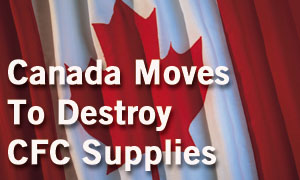
KELOWNA, BC, Canada — The Canadian government and that country’s hvacr industry are moving toward a program that would require the removal of CFCs from even efficiently running, tight systems and having the refrigerants destroyed.
Aspects of that program were presented here during a meeting of RSES Canada. Like the United States, production and importation of CFCs have been banned here since 1995. But it was just in the past few weeks that a program called Extended Producer Responsibility Organization (EPRO) was established by Refrigerant Management Canada (RMC).
EPRO is described as “a formal process for the collection, transportation, storage and disposal of surplus CFC refrigerants.” RMC is a partnership between manufacturers, importers, reclaimers, contractors, and wholesalers.
The CFC program “will use the existing wholesale and retail system, as well as the existing recovery/recycle/reclaim system,” according to a statement from RMC.
“The owner of refrigeration equipment, such as a building air conditioning system or a grocery store freezer, will gain access to the RMC system through the contractor who services the equipment. The contractor will remove the CFCs and return them to the wholesaler and distributor the contractor regularly deals with. They, in turn, will ship the recovered CFCs to a collection center, which will then transport them to the ultimate disposal facility to destroy the chemicals.”
According to Bob Tarlton of Honeywell Genetron, who led the seminar discussion at the RSES Canada meeting, promoters of the RMC program are looking to existing U.S. facilities for the destruction of the CFCs.
He said currently there are no such facilities in Canada.
Proposed Timetables
A series of dates banning the reuse and refilling of CFCs in even properly running systems are being proposed beginning in 2004 with smaller systems and concluding in 2006 with larger units. For example, under the proposed (but not yet approved) plan, a technician who opens a 15-hp system for service work after Jan. 1, 2005, would have to remove the CFC refrigerant and send it off for destruction. An HCFC, HCFC-based, or HFC refrigerant would then have to be put into the system.Funding for the collection of CFCs is covered through a levy on the sale of HCFCs. The levy began this past Jan. 1, even though the actual collection program will not officially go on the books until 2002.
Estimates from two studies done over the past five years maintain that there are 10,000 metric tons of “current and projected inventory of CFCs in equipment and stored for service.” RMC said, “The estimated cost of the disposal process to cover this surplus may be as high as $40 million (Canadian).” That is the reason for the levy, promoters said.
The levy is also designed to avoid the need for end users, contractors, or wholesalers to have to pay the destruction cost at the time the refrigerant is destroyed.
Publication date: 04/16/2001




